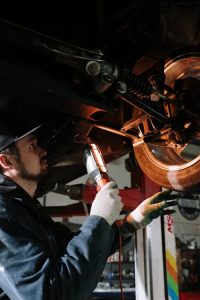Contents
– Valve stem seal: Characteristics
– Replacement of a valve stem seal
– Car repairs in Clayton
You are at the garage, and your mechanic suddenly mentions the need to replace the valve stem seals in your vehicle… Don’t worry. This article gives you all the keys to dealing with this situation!
Valve stem seal: Characteristics
The purpose of valves
There are two types of valves: the exhaust valve and the intake valve. A cylinder has at least one of each, but your engine configuration may have the following:
– 3 per cylinder (2 intakes, 1 exhaust);
– 4 per cylinder (2 intakes, 2 exhaust);
– or 5 per cylinder (3 intake, 2 exhaust).
In the 4-stroke engine, the intake valves open and close at a specific time to allow fresh gases to enter the combustion chamber; the exhaust valves open and close at a specific time to allow burnt gases to escape into the exhaust manifold.
The valves consist of a bellmouth, which closes the intake or exhaust pipe, extended by a cylindrical stem passing through a guide, and opening near the camshaft, which periodically actuates them in translation: the seal between the cylinder head on the oil side and the combustion chamber on the engine side is ensured by the valve stem seal.
Definition of the valve stem seal
It is a member of the lip seal family or SPI seal. Its larger diameter is fitted to the valve guide, and the smaller diameter, consisting of a cylindrical lip with a circular spring, seals the valve stem as it moves.
The valve stem seal seals the valve stem, preventing oil stored in the cylinder head from leaking into the cylinder.
Replacing a valve stem seal
Valve stem seals should be replaced when the following symptoms occur cumulatively
– abnormal oil consumption;
– characteristic blue smoke during deceleration: the engine sucks oil through the valve tails, the pressure in the cylinders being low due to the absence of engine combustion.
There are three possibilities for intervention:
– In the case of diesel engines, if the valves are in the longitudinal axis of the piston previously positioned at TDC, they are unhooked from their return spring and placed on the head of the piston; the valve stem seals are then accessible and can be replaced. Be careful. If the engine accidentally turns over at this point, the piston will drop, and the valve will fall into the cylinder: the cylinder head must be removed!
– On petrol engines, if the valve axis is at an angle to the piston, a valve locking tool is inserted through the spark plug hole.
– In some cases, removing the cylinder head is mandatory, resulting in higher costs.
Good to know: Work on your valve stem seals should only be done by an experienced mechanic.
Where can I find a mechanic in Clayton?

Whether you are driving a brand-new luxury car, a sports car, or something that’s been in the family for years, Seeker Motorsport has the skills and experience to properly diagnose, repair, or replace any part of your vehicle that is too worn out to function correctly.
Hope this post has provided you with the information you were looking for. Remember to jot down a few words in the comments below. Also, let us know if you want to read about a particular car topic. We promise to get to you quickly!




